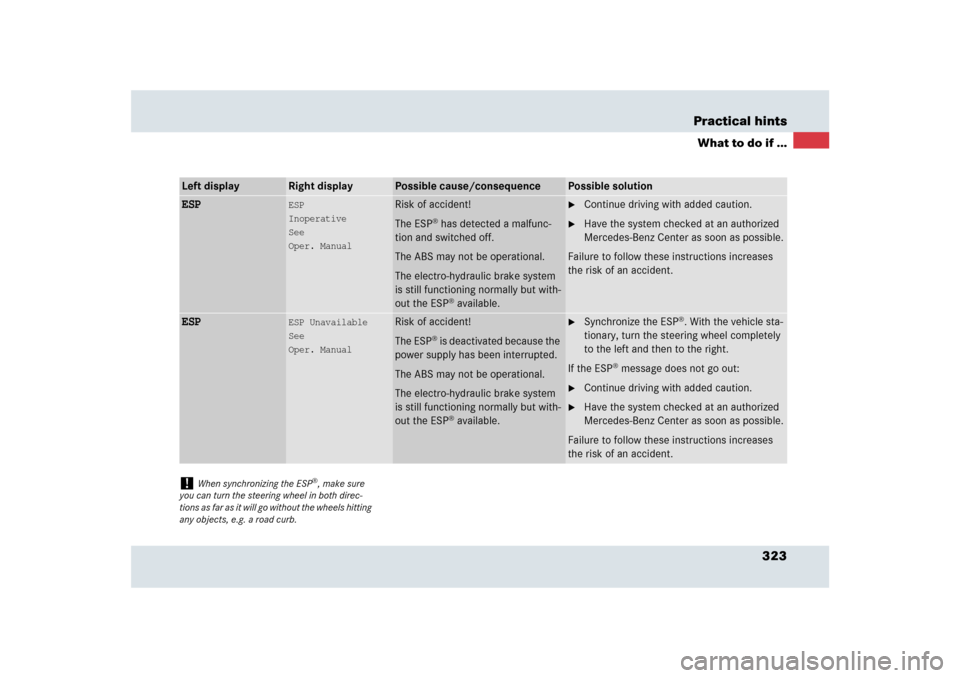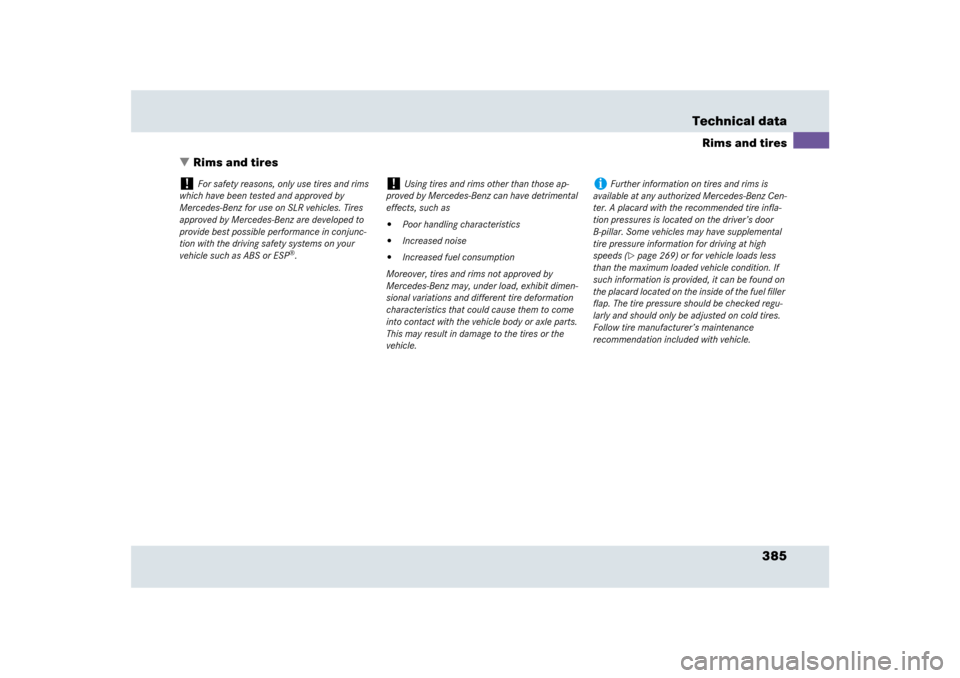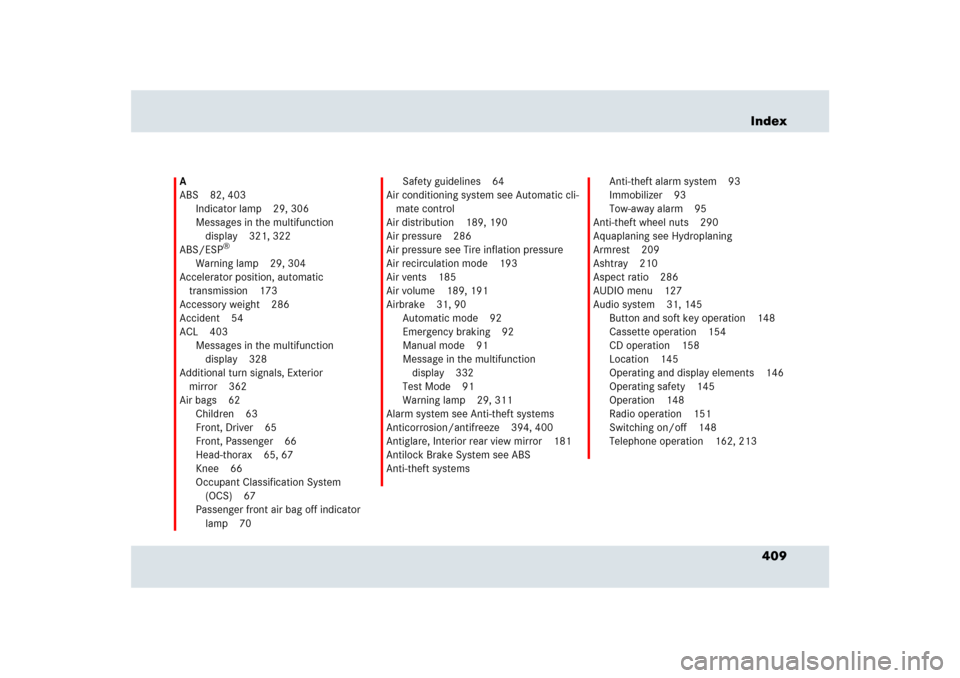Page 321 of 426
321 Practical hints
What to do if ...
Text messagesLeft display
Right display
Possible cause/consequence
Possible solution
ABS
ABS, ESP
Unavailable
See
Oper. Manual
Risk of accident!
The ABS and ESP
® are not available
due to a malfunction. The BAS is also
deactivated.
The system’s self-diagnosis may not
be completed yet.
The electro-hydraulic brake system
is still functioning normally but with-
out the ABS, the ESP®, and the BAS
available.
�
Drive a short distance with added caution at
a vehicle speed of above 12 mph
(20 km/h).
When the message disappears, the ABS, the
ESP
®, and the BAS are available again.
If the message does not disappear:
�
Continue driving with added caution.
Wheels may lock during hard braking,
reducing steering capability.
�
Have the system checked at an authorized
Mercedes-Benz Center as soon as possible.
Failure to follow these instructions increases
the risk of an accident.
Page 322 of 426

322 Practical hintsWhat to do if ...Left display
Right display
Possible cause/consequence
Possible solution
ABS
ABS, ESP
Inoperative
See
Oper. Manual
Risk of accident!
The ABS and ESP
® have switched off
due to a malfunction.
The BAS is also deactivated.
The electro-hydraulic brake system
is still functioning normally but with-
out the ABS, the ESP
®, and the BAS
available.
�
Continue driving with added caution.
Wheels may lock during hard braking,
reducing steering capability.
�
Have the system checked at an authorized
Mercedes-Benz Center as soon as possible.
Failure to follow these instructions increases
the risk of an accident.
––– MPH(USA only)––– Km/h(Canada only)
Cruise Control
One of the activation conditions for
cruise control has not been fulfilled.
For example, you attempted to set a
speed below 20 mph (30 km/h).
�
Drive faster than 20 mph (30 km/h), if the
situation allows, and set the speed.
(�page 205).
The ESP
® is switched off.
�
Switch on the ESP
® (�page 87).
Exceptions: (
�page 86).
Page 323 of 426

323 Practical hints
What to do if ...
Left display
Right display
Possible cause/consequence
Possible solution
ESP
ESP
Inoperative
See
Oper. Manual
Risk of accident!
The ESP
® has detected a malfunc-
tion and switched off.
The ABS may not be operational.
The electro-hydraulic brake system
is still functioning normally but with-
out the ESP® available.
�
Continue driving with added caution.
�
Have the system checked at an authorized
Mercedes-Benz Center as soon as possible.
Failure to follow these instructions increases
the risk of an accident.
ESP
ESP Unavailable
See
Oper. Manual
Risk of accident!
The ESP
® is deactivated because the
power supply has been interrupted.
The ABS may not be operational.
The electro-hydraulic brake system
is still functioning normally but with-
out the ESP® available.
�
Synchronize the ESP
®. With the vehicle sta-
tionary, turn the steering wheel completely
to the left and then to the right.
If the ESP
® message does not go out:
�
Continue driving with added caution.
�
Have the system checked at an authorized
Mercedes-Benz Center as soon as possible.
Failure to follow these instructions increases
the risk of an accident.
!
When synchronizing the ESP
®, make sure
you can turn the steering wheel in both direc-
tions as far as it will go without the wheels hitting
any objects, e.g. a road curb.
Page 366 of 426

366 Practical hintsFlat tireTwo-part sticker1Sticker for instrument cluster
2Sticker for wheel�
Attach sticker part1 where it will be
easily seen by the driver on the instru-
ment cluster.
�
Attach sticker part2 to the damaged
tire (close to the valve).1TIREFIT container
2Flap
3Notch
4Electrical plug
5Air hose
6Flange
�
Open flap 2 on the electric air pump.
�
Pull plug4 and air hose5 out of the
pump housing.
Warning!
G
Take care not to allow the contents of
TIREFIT to come in contact with hair, eyes or
clothing. TIREFIT is harmful if inhaled,
swallowed or absorbed through the skin -
causes skin, eye and respiratory irritation.
Any contact with eyes or skin should be
flushed immediately with plenty of water.
If clothing comes in contact with TIREFIT,
change clothing as soon as possible.
In case of allergic reaction or rash, consult a
physician immediately.Warning!
G
Keep TIREFIT out of reach of children.
If swallowed, rinse mouth immediately with
plenty of water and drink plenty of water.
Do not induce vomiting!
Consult a physician immediately.
Keep away from open flame or heat source.
i
If sealant has leaked out, let it dry. You can
then peel it off.
If you get sealant on your clothing, have it dry-
cleaned as soon as possible.
��
Page 385 of 426

385 Technical data
Rims and tires
�Rims and tires
!
For safety reasons, only use tires and rims
which have been tested and approved by
Mercedes-Benz for use on SLR vehicles. Tires
approved by Mercedes-Benz are developed to
provide best possible performance in conjunc-
tion with the driving safety systems on your
vehicle such as ABS or ESP
®.
!
Using tires and rims other than those ap-
proved by Mercedes-Benz can have detrimental
effects, such as
�
Poor handling characteristics
�
Increased noise
�
Increased fuel consumption
Moreover, tires and rims not approved by
Mercedes-Benz may, under load, exhibit dimen-
sional variations and different tire deformation
characteristics that could cause them to come
into contact with the vehicle body or axle parts.
This may result in damage to the tires or the
vehicle.
i
Further information on tires and rims is
available at any authorized Mercedes-Benz Cen-
ter. A placard with the recommended tire infla-
tion pressures is located on the driver’s door
B-pillar. Some vehicles may have supplemental
tire pressure information for driving at high
speeds (
�page 269) or for vehicle loads less
than the maximum loaded vehicle condition. If
such information is provided, it can be found on
the placard located on the inside of the fuel filler
flap. The tire pressure should be checked regu-
larly and should only be adjusted on cold tires.
Follow tire manufacturer’s maintenance
recommendation included with vehicle.
Page 396 of 426

396 Technical dataFuels, coolants, lubricants, etc.Air conditioning refrigerant
R134a (HFC) refrigerant and special PAG
lubricating oil are used in the air condition-
ing system.
Brake fluid
Only brake fluid approved by
Mercedes-Benz is recommended. Any au-
thorized Mercedes-Benz Center will
provide you with additional information.
Premium unleaded gasoline
!
Never use R12 (CFC) or mineral-based
lubricating oil. Otherwise damage to the system
will occur.
Warning!
G
During vehicle operation, the boiling point of
the brake fluid is continuously reduced
through the absorption of moisture from the
atmosphere. Under extremely strenuous
operating conditions, this moisture content
can lead to the formation of bubbles in the
system, thus reducing the system’s
efficiency.
Therefore, the brake fluid must be replaced
regularly. Refer to your vehicle’s Mainte-
nance Booklet for replacement interval.
Warning!
G
Gasoline is highly flammable and poisonous.
It burns violently and can cause serious
personal injury.
Never allow sparks, flame or smoking
materials near gasoline!
Turn off the engine before refueling.
Whenever you are around gasoline, avoid
inhaling fumes and skin or cloth contact,
extinguish all smoking materials.
Direct skin contact with fuels and the
inhalation of fuel vapors are damaging to
your health.
Page 403 of 426

403 Technical terms
ABS
(A
nti-lock B
raking S
ystem)
Prevents the wheels from locking up
during braking so that the vehicle can
continue to be steered.
Accessory weight
(
�page 286)
ACL
(Airbrake/C
entral L
ocking)
Controls the locking mechanism of the
Airbrake and the central locking
system.
Air pressure
(
�page 286)
Aspect ratio
(�page 286)
Bar
(�page 286)BAS
(B
rake A
ssist S
ystem)
System for potentially reducing braking
distances in emergency braking situa-
tions. The system is activated when it
senses an emergency based on how
fast the brake is applied.
Bead
(
�page 286)
Bi-Xenon headlamps
Headlamps which use an electric arc as
the light source and produce a more in-
tense light than filament headlamps.
Bi-Xenon headlamps produce low
beam and high beam.
CAC
(Customer A
ssistance C
enter)
Mercedes-Benz customer service cen-
ter, which can help you with any ques-
tions about your vehicle and provide
assistance in the event of a
breakdown.CAN system
(C
ontroller A
rea N
etwork)
Data bus network serving to control
vehicle functions such as door locking
or windshield wiping depending on
vehicle settings and/or ambient
conditions.
Cockpit
All instruments, switches, buttons and
indicator/warning lamps in the passen-
ger compartment needed for vehicle
operation and monitoring.
Cold tire inflation pressure
(
�page 286)
Control system
The control system is used to call up
vehicle information and to change
component settings. Information and
messages appear in the multifunction
display. The driver uses the buttons on
the multifunction steering wheel to
navigate through the system and to
adjust settings.
Page 409 of 426

409 Index
A
ABS 82, 403
Indicator lamp 29, 306
Messages in the multifunction
display 321, 322
ABS/ESP
®
Warning lamp 29, 304
Accelerator position, automatic
transmission 173
Accessory weight 286
Accident 54
ACL 403
Messages in the multifunction
display 328
Additional turn signals, Exterior
mirror 362
Air bags 62
Children 63
Front, Driver 65
Front, Passenger 66
Head-thorax 65, 67
Knee 66
Occupant Classification System
(OCS) 67
Passenger front air bag off indicator
lamp 70Safety guidelines 64
Air conditioning system see Automatic cli-
mate control
Air distribution 189, 190
Air pressure 286
Air pressure see Tire inflation pressure
Air recirculation mode 193
Air vents 185
Air volume 189, 191
Airbrake 31, 90
Automatic mode 92
Emergency braking 92
Manual mode 91
Message in the multifunction
display 332
Test Mode 91
Warning lamp 29, 311
Alarm system see Anti-theft systems
Anticorrosion/antifreeze 394, 400
Antiglare, Interior rear view mirror 181
Antilock Brake System see ABS
Anti-theft systemsAnti-theft alarm system 93
Immobilizer 93
Tow-away alarm 95
Anti-theft wheel nuts 290
Aquaplaning see Hydroplaning
Armrest 209
Ashtray 210
Aspect ratio 286
AUDIO menu 127
Audio system 31, 145
Button and soft key operation 148
Cassette operation 154
CD operation 158
Location 145
Operating and display elements 146
Operating safety 145
Operation 148
Radio operation 151
Switching on/off 148
Telephone operation 162, 213